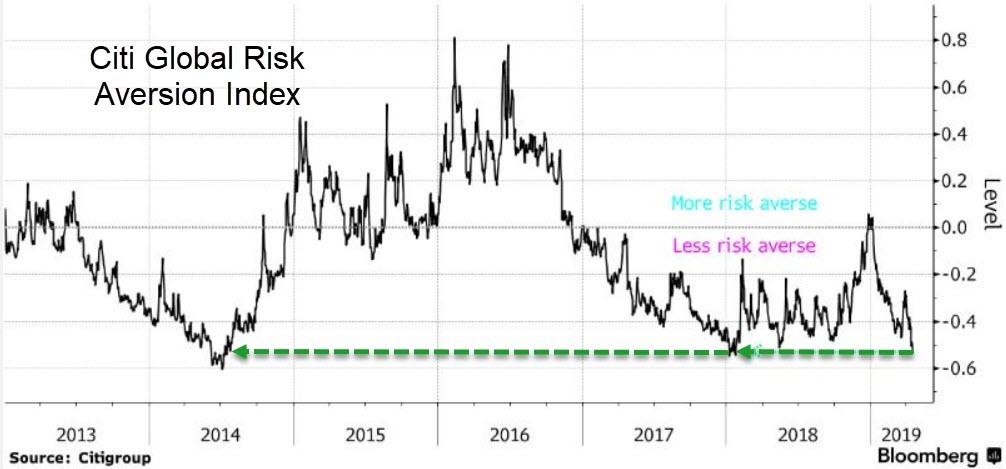Submitted by Nicholas Colas of DataTrek
It isn’t just US equities that exhibit abnormally low expected future price volatility with a CBOE VIX Index reading of just 12.4 today. Implied Volatilities (what the VIX measures) for Emerging Market bonds/stocks, precious metals, and long dated Treasuries are all at or very near 1-year lows just now. EAFE stocks, the Russell 2000 and high yield corporate bonds do show noticeably higher “VIX of” readings, due to worries over European economic growth and late-cycle concerns over access to/cost of credit to marginal borrowers.
We’ll start today with some “news you can use”: if you are ever stuck in an elevator, call 911. In New York City, at least, emergency services treat such an event as serious enough to merit immediate attention. If you just push the service button, you’ll at best get a security guard or doorman. They may or may not feel the same urgency you certainly will. But when the fire department shows up, that will change quickly.
Now, there’s an old market adage that touches on this bit of advice: “stocks take the stairs up but the elevator down”. Bull markets by and large plod along, but bear markets act like a wonky elevator on its way to the lobby but with fits and starts in between. Some of the largest one-day positive moves in US stocks have occurred in volatile, largely down, markets after all.
We bring this up because US stocks are certainly in a bullish stairwell at the moment, with price volatility that barely merits the name:
- The CBOE Volatility Index closed today at 12.4, more than one standard deviation (6 points) from its long run average of 20.
- Actual S&P 500 30-day price volatility, mathematically comparable to the VIX reading, sits at just 9.7%.
- The only reason the VIX is not at an 11-handle: Health Care stocks, where recent price churn has pushed actual volatility to 15.0 and the “VIX of” this group to 18.3.
All this got us to wondering: are US large cap stocks in some sort of bubble of complacency, or are other asset classes exhibiting the same low levels of expected price volatility? To answer that question we looked at options pricing for exchange traded funds linked to assets like junk bonds and gold to determine their current/historical “VIX-type” readings.
Here is what we found:
Fixed Income Markets:
- The “VIX of” +20-year Treasuries show the same lack of concern about future price moves as the CBOE VIX Index. The “VIX of” the TLT ETF is 8.1%, just 2.5% above its one-year lows (set on March 19).
- However, the same is not true for High Yield bonds (HYG ETF), where current Implied Volatility pricing stands at 4.5%, 13% above the one-year lows of 4.0% last July 27th. For comparison, the high was 17.1% on December 24th.
- Investment grade corporate bonds (LQD ETF) currently register one-year “VIX of” lows in their options prices, at 4.0% and tied with the same level on February 4th.
Precious Metals:
- Options on the largest gold ETF (GLD) price Implied Volatility/“VIX of” at 8.1%, which is a one-year low.
- The same measure for options tied to SLV (silver ETF) show Implied Volatility pricing of 14.3%, right on top of one-year lows (14.1% on March 26th).
Non-US Equities/Bonds:
- The “VIX of” options tied to EEM (MSCI Emerging Markets) traded at 14.1% at Friday’s close, a new one-year low.
- MSCI EAFE stocks (EFA ETF) do not, however, share the same low “VIX of” readings; at Friday’s close the Implied Volatility here was 8.9%, 16% higher than the May 10th lows of 7.7%.
- Like their equity cousins, however, Emerging Market bonds (EMB ETF) did see their “VIX” drop to new one year lows on Friday at 5.0%.
Small Cap US Stocks:
- The “VIX of” the Russell 2000 closed on Friday at 9.9, 22% above its one-year lows. This is the largest premium to the 1-year “VIX of” lows of any asset class we cover in this note.
The upshot to all this in three brief takeaways:
- It isn’t just US Large Cap Stocks on the “low-vol staircase”. Treasuries, investment grade bonds, precious metals, and emerging markets stocks/bonds are all in the same low-volatility situation at present.
- We credit this largely to current global central bank policy, which is transparently and unapologetically dovish just now.
Options traders see some possible risk in EAFE stocks due to slowing economic growth in the region. The only other standouts are high yield corporate bonds and US small caps, which traditionally trade together
via ZeroHedge News http://bit.ly/2IQQ9L5 Tyler Durden
